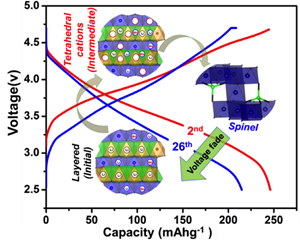
Neutron diffraction analysis provided evidence that LMR-NMC transforms from a layered crystal structure to a spinel phase via an intermediate structure containing cations in the tetrahedral sites. This intermediate structure serves as a building block for the creation of a spinel-like framework that blocks the diffusion pathways.
The deduced key cation migration paths for layered-to-spinel transformations are (1) diffusion of lithium atoms from octahedral to tetrahedral sites in the lithium layer [LiLioct → LiLitet], which is followed by the dispersal of the lithium ions from the adjacent octahedral sites of the metal layer to the tetrahedral sites of the lithium layer [LiTMoct→LiLitet], and (2) migration of Mn from the octahedral sites of the transition-metal layer to the “permanent” octahedral sites of the lithium layer via the tetrahedral sites of the lithium layer [MnTMoct → MnLitet → MnLioct].
These findings suggest that the key to suppressing or eliminating voltage fade behavior could be in minimizing the transition-metal and/or lithium migration using methods such as (1) revisiting compositional phase space or (2) dopant substitution that would stabilize the lattice against excess delithiation.
This research was funded through the DOE Vehicle Technologies Office. The neutron diffraction experiments were conducted on the POWGEN beam line at the Spallation Neutron Source, which is funded by the DOE Office of Science.
D. Mohanty, Jianlin Li, D. P. Abraham, A. Huq, E. Andrew Payzant, David L Wood III, C. Daniel, Unraveling the Voltage-Fade Mechanism in High-Energy-Density Lithium-Ion Batteries: Origin of the Tetrahedral Cations for Spinel Conversion, Chem. Mater., 2014, 26 (21), pp 6272–6280. DOI: 10.1021/cm5031415
For More Information Contact:

